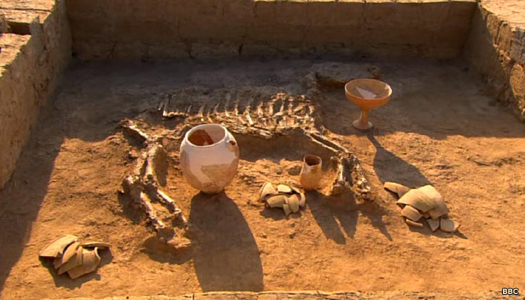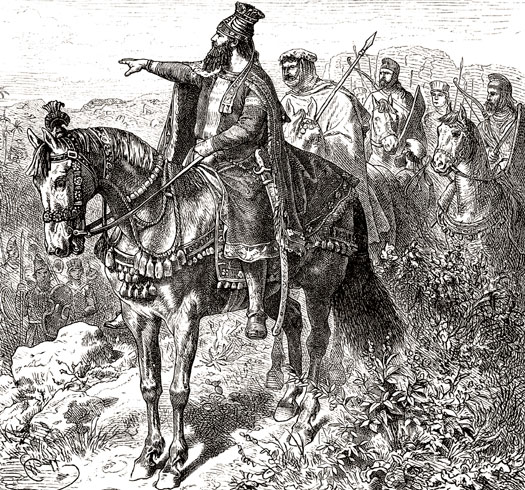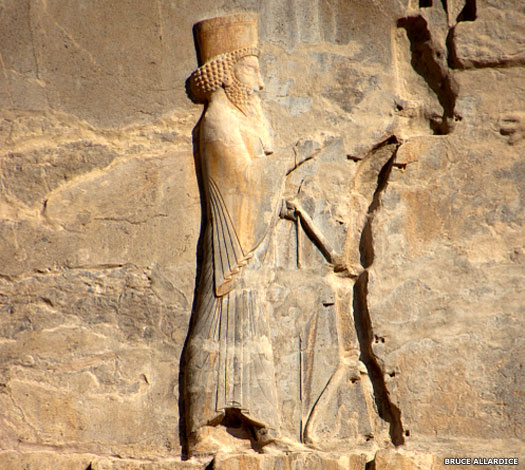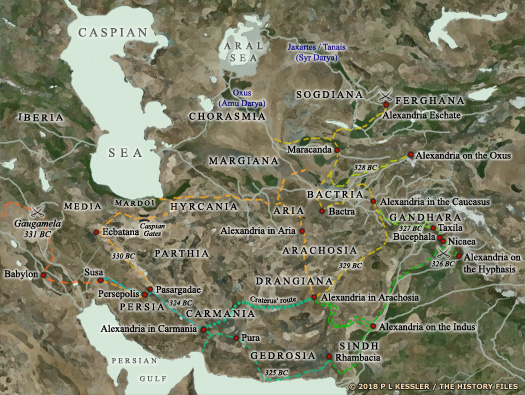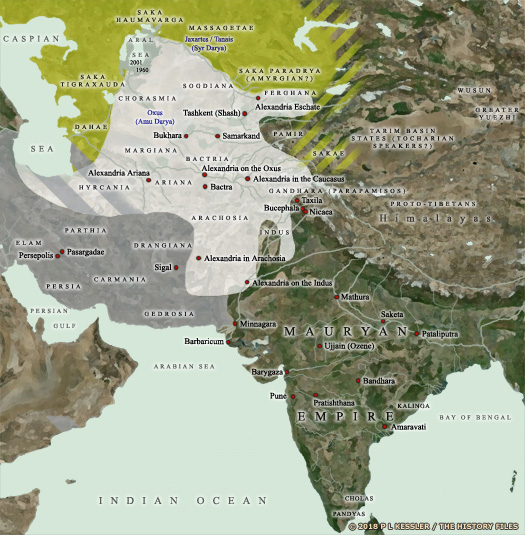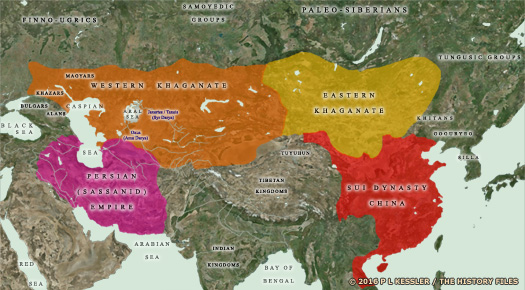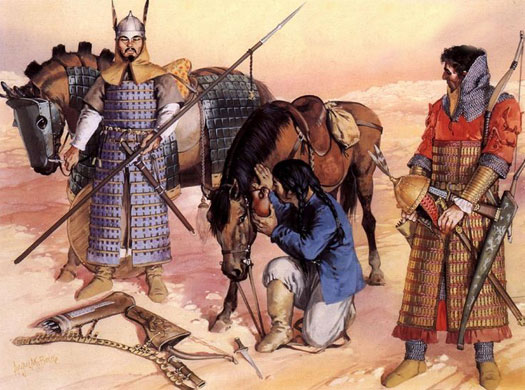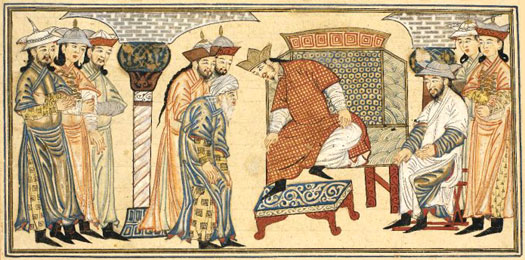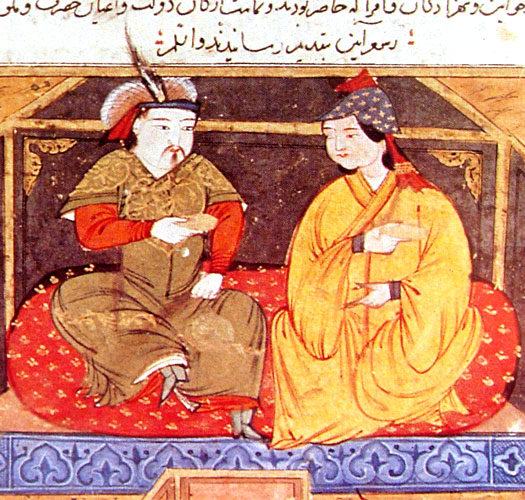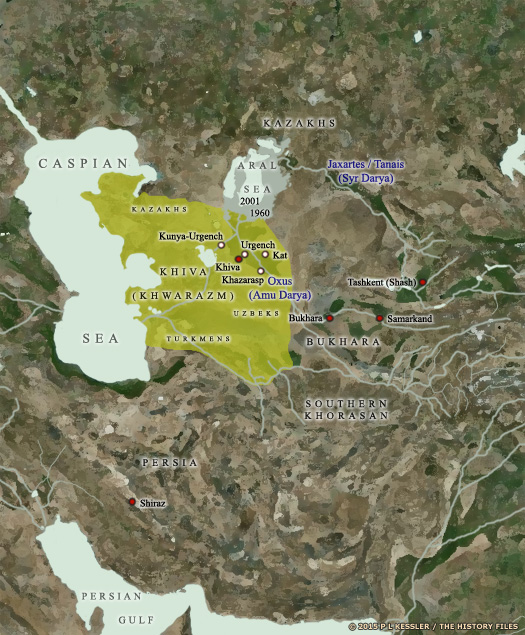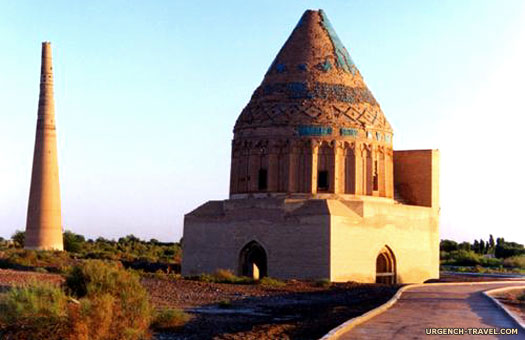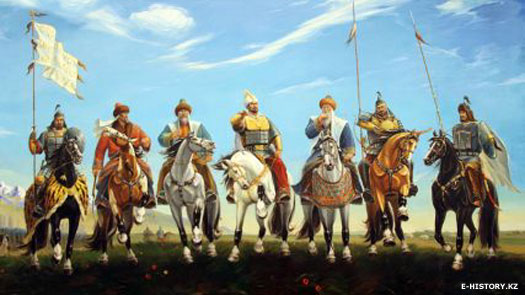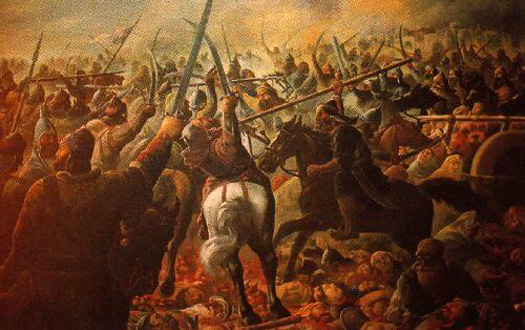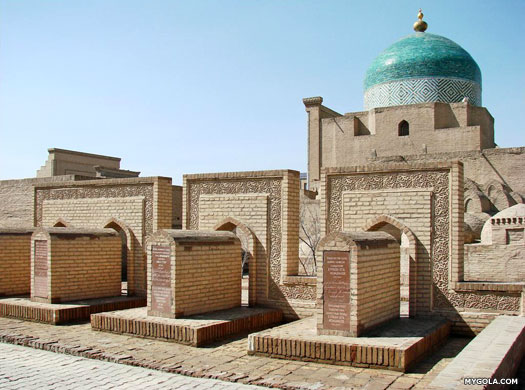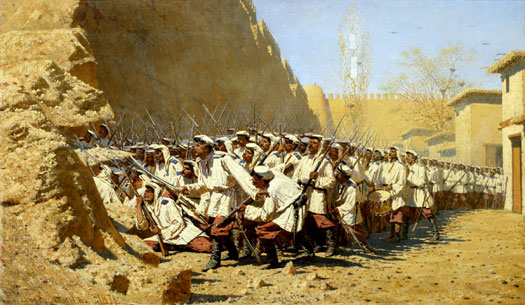
| CHORASMIA / TRANSOXIANA Incorporating the Attasii & Chorasmii, and also Aryana Vaejah :
An ancient and fairly amorphous region, Transoxiana was the home to the oldest series of states in Central Asia. It was generally described as being located in and around the river basin of the lower Amu Darya (the River Oxus) where this empties into the Aral Sea, and in the far reaches of north-eastern Persia. Its territory varied greatly depending on who was ruling it, but at its height it stretched into most of what is now Afghanistan, eastern Persia, central Turkmenistan and southern Kyrgyzstan, plus central and southern Uzbekistan and all of Tajikistan (which together made up the core of ancient Transoxiana). The name now belongs to an eastern province in modern Iran and a region in north-western Uzbekistan.
Transoxiana serves as the crossroads between Central Asia, South Asia, and the Near East. The cities of Bukhara and Samarkand were often included in the region, which could also encompass a large number of other such cities. The Kel-teminar culture began the process of climbing towards civilisation from around 6000 BC. The first millennium BC satrapy of Chorasmia generally formed the western section of this region. The name received its first historical mention in the Avesta. It was bounded by the Kizil Kum Desert to the north-east, in the corner formed by the meeting between the Syr Darya (the River Jaxartes or Iaxartes) and the Aral Sea, and the Kara Kum Desert between the Oxus and the Caspian Sea.
Three groups of Indo-Europeans were identified by ancient authors as being inhabitants in or around Chorasmia is the later first millennium BC. One of these were the Saka Tigrakhauda who occupied open grasslands around the Aral Sea, in modern south-western Kazakhstan. The pointed caps they wear would be sized according to seniority, with the tallest being reserved for the chieftain. This group of Sakas has been linked to the Massagetae of Strabo, who bordered the region to the north in the sixth century BC. However, it seems highly likely that the Massagetae were Scythians of a sort, and a distinction is drawn in ancient records between Scythians and Saka. Strabo also identified the Attasii and the Chorasmii (Chorasmians or Choramnians) of Chorasmia as Massagetae, making them sub-groups of the main Massagetae collective. Athenaios places the Chorasmii to the east of the Persian satrapy of Parthawa. The earliest known rulers in Transoxiana are placed in the 600s BC, but these are based on an oral history which was only written down much later. Then Chorasmia (and most of Transoxiana) was conquered by the Persians.
Aryana Vaejah (or Airyanem Vaejah) translates as the 'expanse of the Aryans'. It was part of the core homeland of the early Indo-Iranians in the late second millennium and early first millennium BC. Its precise location in historical terms is extremely uncertain. In the first chapter of the Vendidad (or Videvdat, a collection of texts within the greater compendium of the Avesta) is a listing of sixteen countries, with Aryana Vaejah lying to the north of these. If the Indo-Iranian land of Tūr and the later kingdom of Turan can be taken as the northern heartland of Indo-Iranian territory, and Ariana the southern heartland, then Aryana Vaejah could be equated with Chorasmia to the north and west of them. James Darmesteter in his translation of the Avesta states that it lay beside Azerbaijan, which is acceptable if it is on the eastern side, meaning that it was on the other side of the Caspian Sea. Bahram Farahvashi, Nasser Takmil Homayoun, and Elton L Daniel all place it in Chorasmia. Controversially, it has also been located at the heart of the sixteen countries rather than on their edge.
(Information by Peter Kessler, with additional information by Edward Dawson, from Epitome of the Philippic History of Pompeius Trogus: Books 11-12, Volume 1, Marcus Junianus Justinus, John Yardley, & Waldemar Heckel, from The Persian Empire, J M Cook (1983), from The Histories, Herodotus (Penguin, 1996), from The Great Soviet Encyclopaedia, Third Edition (1970-1979), from Kharazm: What do I know about Iran? Nasser Takmil Homayoun (2004), from The History of Iran, Elton L Daniel (2001), and from External Links: the Ancient History Encyclopaedia (dead link), and Zoroastrian Heritage, K E Eduljee, and Talessman's Atlas (World History Maps), and Encyclopaedia Iranica, and The Deipnosophists, Athenaeus (C D Yonge, Ed), and Sacred Books of the East, James Darmesteter (1898), now available online via Avesta - Zoroastrian Archives, Joseph H Peterson, and the works of Bahrām Farahvai (Encyclopaedia Iranica), and Hystaspes (Encyclopaedia Britannica).)
c.2200 - 1700 BC :
An indigenous Bronze Age culture emerges in Central Asia between modern Turkmenistan and down towards the Oxus, the somewhat nebulous region known as Transoxiana. It is known as the Bactria-Margiana Archaeological Complex, or Oxus Civilisation (centred on the later provinces of Bactria and Margiana). Indo-European tribes which have not taken part in the exodus to the west or south soon integrate themselves into it.
This king's tomb in the Indo-European settlement in the Karakum (modern Turkmenistan) contains a valuable horse to accompany him into the afterlife 2000 - 1700 BC :
Climate change from around 2000 BC onwards greatly affects this civilisation, denuding it of water as the rains decline. The people are forced to migrate away, abandoning many of their cities. Indo-Iranian groups become dominant here, and over time some of their descendants enter Iran to found states such as that of the Mannaeans, the Median empire, and early Persia. Some go even farther even earlier to form the Mitanni empire. Others cross the rivers of what is now Afghanistan and the Hindu Kush mountains and enter India between 1700-1500 BC. They eventually form their own kingdoms there such as Magadh, plus Kaling, and the Kaurav state.
fl 588 BC :
Vishtāsp / Hystaspes / Gushtasp : Zoroastrian ruler of Aryana Vaejah. Known by several variations of his name - including Kay Wishtaspa (with kay or kai being an Indo-Iranian term for 'king') or 'Vishtaspa' without any accented letters - Vishtāspa is Zoroaster's earliest kingly supporter. Having thrown him into prison for challenging the established priestly order, the king subsequently releases him after he heals the king's favourite horse. Then he converts to Zoroastrianism and becomes an enthusiastic supporter. Several other kings also convert in light of this development.
Following the climate-change-induced collapse of indigenous civilisations and cultures in Iran and Central Asia between about 2200-1700 BC, Indo-Iranian groups gradually migrated southwards to form two regions - Tūr (yellow) and Ariana (white), with westward migrants forming the early Parsua kingdom (lime green), and Indo-Aryans entering India (green) c.546 - 540 BC :
The defeat of the Medes opens the floodgates for Cyrus the Great with a wave of conquests, beginning in the west from 549 BC but focussing towards the east of the Persians from about 546 BC. Eastern Iran falls during a more drawn-out campaign between about 546-540 BC, which may be when Maka is taken (presumed to be the southern coastal strip of the Arabian Sea). Further eastern regions now fall, namely Arachosia, Aria, Bactria, Carmania, Chorasmia, Drangiana, Gandhar, Gedrosia, Hyrcania, Margiana, Parthia, Saka (at least part of the broad tribal lands of the Sakas), Sogdiana (with Ferghana), and Thatagush - all added to the empire, although records for these campaigns are characteristically sparse.
Persian Satraps of Uwarazmiy (Chorasmia) :
Conquered in the mid-sixth century BC by Cyrus the Great, the region of Chorasmia was added to the Persian empire. Before that it was populated largely by Indo-Iranian tribal groups, and especially by the Chorasmii tribe, while the kingdom of Aryana Vaejah existed within the region in the early sixth century. Under the Persians it was formed into an official satrapy or province which, according to the Behistun inscription of Darius the Great, was called Uwarazmiy or Uvārazmī (Chorasmia is a Greek mangling of the name).
The location of the capital is uncertain - two locations seem to have provided this function, at the first century AD Topraq Qala (Toprak Qala) to the north-west of Bostan which is more likely to have been a summer residence, and at Dzanbas Qala. In fact when the first of these was at the height of its use the capital is known to have been at Axsha-Xan qala, fourteen kilometres to its south-west - a city that may once have been called Darg'ash. None of that helps with an Achaemenid-era capital though - but Herodotus mentions Uwarazmiy and Parthawa together in a description of the taxes under Darius I and in a catalogue of army units under Xerxes, raising the possibility that the satrapy was in fact ruled from Parthawa.
These eastern regions of the new-found empire were ancestral homelands for the Persians. They formed the Indo-Iranian melting pot from which the Parsua had migrated west in the first place to reach Persis. There would have been no language barriers for Cyrus' forces and few cultural differences. Although details of his conquests are relatively poor, he seemingly experienced few problems in uniting the various tribes under his governance. He was the first to exert any form of imperial control here, although his campaign may have been driven partially by a desire to recreate the semi-mythical kingdom of Turan in the land of Tūr, but now under Persian control. Curiously the Persians had little knowledge of what lay to the north of their eastern empire, with the result that Alexander the Great was less well-informed about the region than earlier Ionian settlers on the Black Sea coast had been.
The main satrapy of Uwarazmiy was one of those more unusual provinces in which nomads were governed by indigenous rulers. At the time of Alexander the territory largely coincided with the expanse of the Karakum Desert and covered roughly a rhombus-shaped area, which in the north-east was separated from the territory of the Massagetae by the River Oxus (the Amu Daryā). To the north-west the old Oxus branch, the Uzboy, marked the boundary. From the eastern corner of the rhombus near modern Charjuy in Turkmenistan, the border must have run south-west toward the Hyrcanian border, which it followed west and north-west until it reached the Uzboy again.
(Information by Peter Kessler, with additional information from The Persian Empire, J M Cook (1983), from The Histories, Herodotus (Penguin, 1996), from Anabasis Alexandri, Arrian of Nicomedia, from Farāmarz, the Sistāni Hero: Texts and Traditions of the Farāmarznāme and the Persian Epic Cycle, Marjolijn van Zutphen, from Ctesias' Persica in its Near Eastern Context, Matt Waters, from Alexander The Great: In the Realm of Evergetǽs, Reza Mehrafarin, and from External Links: Encyclopaedia Iranica, and Topraq Qala, and The Geography of Strabo (Loeb Classical Library Edition, 1932), and The Natural History, Pliny the Elder (John Bostock, Ed), and Livius.org.)
c.546 - 540 BC :
During his campaigns in the east, Cyrus the Great initially takes the northern route from Persis towards Bakhtrish to reassure or subdue the provinces. This route probably involves the 'militaris via' by Rhagai to Parthawa. At some point he takes the more difficult southern route, destroying Capisa along the way (possibly Kapisa on the Koh Daman plain to the north of Kabul - which is possibly also the Kapishakanish named by the Behistun inscription as a fortress in Harahuwatish).
Cyrus the Great freed the Indo-Iranian Parsua people from Median domination to establish a nation that is recognisable to this day, and an empire that provided the basis for the vast territories that were later ruled by Alexander the Great 515 BC :
One of the three Saka 'nations' is that of the Saka Paradraya. This name breaks down into 'para' and 'draya', the first part meaning 'across' and the latter almost certainly being 'darya' or 'river'. When Persian ruler Darius the Great boasts of the limits of his empire he gives as the north-eastern corner the 'Sakaibish tyaiy para Sugdam' - the Sakas across/beyond Suguda, on the other side of the River Tanais (otherwise known as the Jaxartes/Iaxartes or Syr Darya, which forms the boundary between Suguda and Scythia). If these Saka do not border Uwarazmiy directly then another group, the Saka Tigrakhauda, may do.
479 - 465 BC :
Xerxes apparently adds two new regions to the Persian empire during his reign, neither of which are very descriptive or clear in their location. The first is Daha, from 'daai' or 'daae', meaning 'men', perhaps in the sense of brigands. Daha or Dahae would appear to be the region on the eastern flank of the Caspian Sea, bordered by the Saka Tigraxauda to the north, and the satrapies of Mergu, Uwarazmiy, and Verkâna to the north-east, south-east, and south respectively. It contains a confederation of three tribes, the Parni, the Pissuri, and the Xanthii.
360s/350s BC : Artaxerxes II is occupied fighting the 'revolt of the satraps' in the western part of the empire. Nothing is known of events in the eastern half of the Persian empire at this time, but no word of unrest is mentioned by Greek writers, however briefly. Given the newsworthiness for Greeks of any rebellion against the Persian king, this should be enough to show that the east remains solidly behind the king. It seems that all of the empire's troubles hinge on the Greeks during this period.
Artaxerxes II of Persia is immortalised in relief at the entry to his tomb in Persepolis, having survived a reign that began with a series of revolts and included war against the troublesome Greeks (External Link: Creative Commons Licence 2.0 Generic) There are suggestions, however, that Uwarazmiy has edged away from direct control to establish its own kingship. This is uncertain though, and could be little more than a late claim of independence while Alexander the Great is taking control of eastern regions in 330-329 BC.
fl c.340s? :
Phrataphernes : Satrap? Probably native noble. Later in Parthawa & Verkâna.
? - 330 BC :
Pharasmanes : Son. Satrap. 'King of the Chorasmians'. Retained.
330 BC :
In 330 BC Suguda becomes part of the Greek empire despite the efforts of Bessus, self-styled 'king of Asia', to retain at least some of the Persian territories. His claim is legal, since Bakhtrish is traditionally commanded by the next-in-line to the throne, but Persia has already been lost and his loose collection of eastern allies provides nothing more than a sideshow to the main event - the fall of Achaemenid Persia. Still, it takes Alexander the Great two more years to fully conquer the region.
The writer Arrian mentions the arrival of Pharasmanes, so-called king of the Chorasmians (a title designed to increase Alexander's own position as a conqueror of kings), with a cavalry force of some fifteen hundred men. The Chorasmians follow a wait-and-see policy until Alexander reaches Bactra, after which Pharasmanes acknowledges him as his overlord. He offers to guide Alexander to the Black Sea should he wish to campaign there, although Alexander declines the offer. Instead he concludes a 'friendly pact' with Pharasmanes and allows him to remain in his post.
Argead Dynasty in Chorasmia :
The Argead were the ruling family and founders of Macedonia who reached their greatest extent under Alexander the Great and his two successors before the kingdom broke up into several Hellenic sections. Following Alexander's conquest of central and eastern Persia in 331-328 BC, the Greek empire ruled the region until Alexander's death in 323 BC and the subsequent regency period which ended in 310 BC. Alexander's successors held no real power, being mere figureheads for the generals who really held control of Alexander's empire. Following that latter period and during the course of several wars, Chorasmia was left in the hands of the Seleucid empire from 312 BC.
(Additional information from A Dictionary of Greek and Roman Biography and Mythology, William Smith (London, 1873).)
330 - 323 BC :
Alexander III the Great : King of Macedonia. Conquered Persia.
323 - 317 BC :
Philip III Arrhidaeus : Feeble-minded half-brother of Alexander the Great.
317 - 310 BC :
Alexander IV of Macedonia : Infant son of Alexander the Great and Roxana.
330 - 328 BC :
Pharasmanes : Retained as the Achaemenid satrap of Uwarazmiy.
328 - 321 BC :
Amyntas Nikolaos : Greek satrap of Chorasmia, Bactria, & Sogdiana.
328 - 321 BC :
Scythaeus : Greek satrap of Chorasmia, Bactria, & Sogdiana.
323 - 321 BC :
Philip / Philippus : Greek satrap of Chorasmia, Bactria, & Sogdiana, then Parthia.
321 BC : With Philip being reassigned to Parthia, his replacement in the east is Stasanor the Solian, former satrap of Aria and Drangiana. This new satrap is the brother to Stasander, his replacement in Aria and Drangiana. Perhaps he also has more of a focus towards the Northern Indus territories than the eastern coast of the Caspian Sea, as later suggested by events. His territory initially extends as far north as Ferghana, which contains the city of Alexandria Eschate ('the Furthest'), while Stasander also has ambitions.
The route of Alexander's ongoing campaigns are shown in this map, with them leading him from Europe to Egypt, into Persia, and across the vastness of eastern Iran as far as the Pamir mountain range In the 320s BC, the Persians and the Greeks under Alexander place the Amyrgian Sakas beyond Sogdiana, across the River Tanais (otherwise known as the Iaxartes, Jaxartes, or Syr Darya, which forms the boundary between Sogdiana and Scythia). This is thanks to their having encountered them after crossing Sogdiana and the Syr Darya in the approximate region of Alexandria Eschate. It is generally accepted that they control all of Ferghana and the Alai valley. Indeed, they may have been relocated onto the plain following their conquest by the Persians.
321 - 312 BC :
Stasanor the Solian : Greek satrap of Chorasmia to Sogdiana, & Nth Punjab (316 BC).
316 - 312 BC :
The Wars of the Diadochi decide how Alexander the Great's empire is carved up between his generals, but the period is very confused, especially in the east. These provinces appear to be invaded and controlled by the Antigonids for a period, with General Antigonus being responsible for the death of Eudamus. However, at some point in 316 BC, Stasanor the Solian, satrap of Chorasmia, Bactria, and Sogdiana (with Ferghana) seizes the Northern Indus while his brother seizes Parthia. Clearly the two are either working in unison with Seleucus of Babylonia from the beginning or are attempting to stamp their own independent authority on much of the east. Unfortunately, Stasander is removed from office in 315 BC.
312 - 306 BC :
Bactria is taken by the Seleucids around 312 BC. During the break-up of the empire, it appears that parts of the area become independent, but much of it remains under the control of the Greek satrap of Bactria and Sogdiana and, after 256 BC, the kings of Bactria.
Macedonian Chorasmia :
Middle Persian Xwarāsān.
The location of the capital is somewhat confused. Two locations seem to have provided this function, these being the first century AD Topraq Qala (Toprak Qala) to the north-west of Bostan which is more likely to have been a summer residence, and Dzanbas Qala. In fact when the first of these was at the height of its use the capital is known to have been at Axsha-Xan qala, fourteen kilometres to its south-west - a city that may once have been called Darg'ash. Topraq Qala continued to be used until the sixth century, although the palace was briefly abandoned during the fourth century (see details, below), and was later restored and possibly used as an administrative centre for the associated city. In the medieval period the site was occupied by squatters until the Mongols invaded in the early thirteenth century.
(Additional information from The Cambridge History of Iran, Volume 3, E Yarshater (Ed), and from External Link: Topraq Qala.)
c.294 - 293 BC :
A former general under Seleucid rulers Seleucus I Nicator and Antiochus I Soter, Demodamas later serves twice as satrap of Bactria and Sogdiana. During this time he undertakes military expeditions across the Syr Darya to explore the lands of the Sakas, repopulating Alexandria Eschate ('the furthest', modern Khojend) in the process following its earlier destruction by barbarians.
c.165 BC :
Defeated by the Xiongnu, the Greater Yuezhi are forced to evacuate their lands on the borders of the Chinese kingdom. They begin a migration westwards that triggers a slow domino effect of barbarian movement.
140 - 130 BC : Sakas have long been pressing against Bactria's borders. Now, following a long migration from the borders of the Chinese kingdom, the Greater Yuezhi start to invade Bactria from Sogdiana to the north. Initially, Saka elements who are already in Bactria become vassals to the Greater Yuezhi.
The kingdom of Bactria (shown in white) was at the height of its power around 200-180 BC, with fresh conquests being made in the south-east, encroaching into India just as the Mauryan empire was on the verge of collapse, while around the northern and eastern borders dwelt various tribes that would eventually contribute to the downfall of the Greeks - the Sakas and Greater Yuezhi At around the time of the death of the Indo-Greek King Menander in 130 BC, the Greater Yuezhi overrun Bactria and end Greek rule. Heliocles may possibly invade the western part of the Indo-Greek kingdom, as there are strong suggestions that the Eucratids continue to rule there, especially in Heliocles' presumed son, Lysias.
After Bactria's destruction and occupation by the Greater Yuezhi, the region is later inhabited by Zoroastrian Indians who use Aramaic script. Sogdiana is for the most part independent.
115 - 100 BC :
With Parthian territory having been harried for years by the Sakas, King Mithridates II is finally able to take control of the situation. First he defeats the Greater Yuezhi in Sogdiana in 115 BC, and then he defeats the Sakas in Parthia and around Seistan (in Drangiana) around 100 BC. After their defeat, the Greater Yuezhi tribes concentrate on consolidation in Bactria-Tokharistan while the Sakas are diverted into Indo-Greek Gandhar. The western territories of Aria, Drangiana, and Margiana would appear to remain Parthian dependencies.
c.AD 112 - 132 :
Kushan ruler Kanishk expands his empire even further. He annexes the various regions of India; Uttar Pradesh, Bihar, Kashmir, Malwa, Rajputana, Saurashtra, and extends his rule as far as Khotan (southern India). He also captures Transoxiana (modern Tajikistan and southern Uzbekistan). He makes Purushpura (present day Peshawar in Pakistan) his capital and appoints kshatrapas to rule his vast territories, including in the former territory of the Sakas (Saka officials remain in office in Mathura). He may also use Greek script on his earlier coins, inherited from influences in former Bactria which may still be evident in his day.
c.350/375 :
The style of regional coins suddenly changes in the second half of the fourth century, or towards the end of it. Probably not coincidentally, the palace at Topraq Qala is briefly abandoned during the fourth century. It is later restored and possibly used as an administrative centre for the associated city, but something clearly changes in the fourth century.
Coins which have imitated Greek types for over four centuries - especially the tetradrachms of Euthydemus I, former Greek satrap of Sogdiana - are no longer issued, being replaced with coins of a quite different appearance. These are small silver coins with a head-and-shoulders representation in the Transoxianan style of a ruler in a diadem on the obverse, and on the reverse an altar with a blazing fire and a circular legend in Sogdian in which only the title MR'Y can be read. Similar coins are issued in copper. Both are ancestors of a new generation of coins which are linked to Bukhara right up to the seventh century (possibly due to the rise there of a ruling elite which survives until the Islamic invasion).
500s :
A class of Post-Hephthalite empire Alchon coins would seem to require classification as a separate entity. They are distinguished by the area of their influence outside north-western India. Among these, two kings include a legend on their coins that reads 'the King of the East'. This is particularly interesting since this legend connects these Alchon kings both to later Turkic rulers of the region, including the 'Tegin of Khorasan' and the later division of the Sassanid empire into four distinctive (military) administrative divisions. One of these divisions indeed receives the Middle Persian name of Xwarāsān, generally shown in English texts as Khorasan, an exact parallel of the Bactrian μιιρασανο with the same meaning of 'the east'.
530s - 540s :
The significant setbacks experienced by the Sassanids in the latter part of the fifth century - directly caused by the Hephthalites - are a prime motivator for reforms that are undertaken by shahs Kavad and Khosrow I. Most significantly, the creation of four major defensive, and presumably administrative, zones in the Sassanid administration is a direct response to the inefficiency of centralised defence. The north-east and east of the empire are entrusted to an Ispahbed of Khwarasan (Khwarasan being Chorasmia, while this is the first time that 'Ispahbed' appears in history, meaning an army chief).
552 :
The Western khagans expand their dominion towards Chorasmia and Sogdiana, right up against the borders of Persia's eastern territories.
As was often the case with Central Asian states that had been created by horse-borne warriors on the sweeping steppelands, the Göktürk khaganate swiftly incorporated a vast stretch of territory in its westwards expansion, whilst being hemmed in by the powerful Chinese dynasties to the south-east and Siberia's uninviting tundra to the north 651 - 821 :
Large areas of the territory (mostly western Afghanistan and large swathes of Chorasmia) are conquered by the Islamic empire as it takes Sassanid Iran, although Kabul remains independent as does neighbouring Zabulistan. Governors, or emirs, are appointed to control the Islamic emirate of Khorasan in the name of the caliph. A seemingly partial occupation of Transoxiana by Tang dynasty China is effected in 659, but is ended in 665.
Islamic
Emirate of Khorasan / Khurasan :
Following the Islamic conquest of Sassanid Persia and its eastern territories in Transoxiana, governors were put in place to command this great, tumultuous region (although something of this reorganisation may already have taken place under the Sassanids). Rather than maintain a series of minor provinces which had existed in one form or another since the initial Achaemenid conquest of the east under Cyrus the Great, it would seem that the province of Chorasmia was now greatly enlarged, becoming known as Greater Khorasan. This included many of the old provinces within its territory, Aria and Margiana being two of them. To govern the region, emirs were appointed by the caliph in Syria during the seventh century.
The name Khorasan was a direct inheritance from the Achaemenid empire. The forces of Cyrus the Great took the region during a sweeping campaign of acquisition across the southern parts of Central Asia in the mid-sixth century BC. The western part of Transoxiana contained an Indo-Iranian tribe called the Chorasmii, from which the Persian province name of Uwarazmiy was formed (Chorasmia to the Greeks). The initial 'u' seems to have softened (or was originally pronounced) as a soft 'kh' sound so that kh-waraz-me could be pronounced by its Islamic conquerors as khwarazam or khorasan. Around AD 520 the Sassanids had created four major defensive, and presumably administrative, zones in the east as direct response to the inefficiency of centralised defence in the face of Hephthalite attacks. The north-east and east of the empire were entrusted to an Ispahbed of Khwarasan (Khwarasan being the Middle Persian version of Uwarazmiy, while this was the first time that 'Ispahbed' appeared in history, meaning an army chief).
(Additional information from The Secret History of Iran, Hamad Subani, from King of the Seven Climes: A History of the Ancient Iranian World (3000 BCE - 651 CE), Khodadad Rezakhani (Touraj Daryaee, Ed, Ancient Iran Series Vol IV, 2017), from The Fragmentary Classicising Historians of the Later Roman Empire, R C Blockley (Francis Cairns, Oxford, 1983), and from External Links: Zoroastrian Heritage, and The Silk Road.)
mid-650s :
A king of Kabul - seemingly unnamed - apparently faces off against the young Islamic general, Al-Muhallab ibn Abi Sufra, in an heroic battle. Kabul's well-provisioned troops are able to hold their own and the two leaders subsequently agree to peaceful coexistence. Al-Muhallab later becomes governor of Khorasan (in 698).
666 :
Tarikh-e Sistan of eleventh century Seistan provides an extensive account of the wars of a Rutbil of Seistan and Zabulistan against the Muslim conquerors of the region. These wars, starting with the confrontation in Sakastan with Islam's Rabi' al-Harithi (Hārithī) in 666, continue well into the ninth century when another Rutbil is defeated by Yaghub bin Laith, founder of the AsiaDrangiana.htm#Saffarids of Seistan.
671 - 673 :
Rabi ibn Ziyad al-Harithi : Umayyad governor of Greater Khorasan. Formerly in Sakastan.
673 - ? :
Abdallah ibn Rabi : Son.
698 - ? :
Al-Muhallab ibn Abi Sufra : Umayyad governor of Greater Khorasan.
?
Yazid ibn al-Muhallab : Son.
704/705 - 716 :
Qutaiba ibn Muslim : Umayyad governor of Greater Khorasan.
708/709 :
Qutaiba ibn Muslim expels Vardan Khuda from Bukhara.
717 - 719 :
Al-Jarrah ibn Abdallah : Umayyad governor of Greater Khorasan.
717 - 738 :
Sulu of the Western Göktürk khaganate is claimed as being the founder of the minor Türgish dynasty, a Turkic tribe (or tribes) that had been subject to the khaganate but which now finds itself independent. Based in Transoxiana after being moved there during the great days of the khaganate, the Türgish now find themselves being defeated alongside the Sogdians by invading Umayyad Arabs.
Sulu is elected their leader in 717, and he marshals the Sogdian and Türgish defences independent of Göktürk authority. Fighting a largely hit-and-run-based war in the region's deserts, he enjoys a decade of success, including victory at the Battle of the Defile in 731. Unfortunately, internal politics ends his success when he is killed in 737/737 by one of his own relatives. The Türgish splinter into two factions.
This modern artist's impression shows three early Turkic warriors, from left to right, a Göktürk armoured cavalryman, an Eastern Turk tribesman, and a Türgish 'tarkan' champion 719 :
From this date, the Abbasids begin to seek followers to their cause of removing their sworn enemies, the Umayyad caliphs, from power. They also target the supporters of the failed rebellion by al-Mukhtar in 686.
c.738 :
The son and successor of Burha Tegin of Kabul is from Kesar who, according to scholars, must ascend the throne of Kabul shortly before 738, although he is possibly a powerful viceroy who is based in the eastern capital of Wayhind in Uddiyana. The coins carrying his name and titles read 'Phromo Kesaro the Mighty (?) the King, the Lord', and 'From Kesar, His Majesty, the Lord, who smote the Arabs', in a countermark, thereby showing his successes in fights against the Islamic empire. It could be speculated that Phromo Kēsaro is either the same as the Rutbil of the Islamic sources, or is the 'Kabulshah' (ruler of Kabul) on whom the Rutbil, the possible series of local rulers of Zabulistan, are relying for their continued fight against the Muslim governors of Sakastan.
747 - 749 :
The Abbasids under Abu Muslim begin an open revolt in Khorasan against Umayyad rule. Khorasan quickly falls under their command and an army is sent westwards. Kufa falls in 749 and in November the same year Abu al-Abbas is recognised as caliph.
821 :
The Tahirid emirs are established in Khorasan, which includes what is now northern and western Afghanistan up to the borders of the kingdom of Zabulistan, when the region is granted to them by the Abbasid caliph, al-Mamun.
Tahirid
Emirs of Khorasan :
The eastern province which included Persia and Khorasan lost Transoxiana to the Samanids. Abbasid Caliph al-Mamun appointed Tahir ibn al-Hussein, the successful commander of a campaign which had defeated the caliph's main rival, as the new governor of Khorasan, beginning the Tahirid period of rule in the east (sometimes shown as Tahrid). Tahir had previously been governor, or wali, of Syria (815-821), but he effectively declared independence in his new domains by failing to mention the caliph during a sermon at Friday prayers in AD 822. Unfortunately, the new emir died the following day.
821 - 822 :
Tahir I ibn al-Hussein : General to the Abbasid Caliph al-Mamun. Declared independence.
822 :
Despite Tahir's apparent declaration of independence, upon his sudden death, Abbasid Caliph al-Mamun appoints his son, Talha, to the post of faithful governor of the eastern Persian lands.
822 - 828 :
Talha : Son. Died.
828 - 830 :
Ali ibn Tahir ibn al-Hussein : Brother. Deputy governor.
828 - 830 :
Ali acts as deputy governor for his brother for the two years it takes the latter to take up his office. After having succeeded his father as governor of Syria he defeats the rebel, Nasr ibn Shabath between 824-826. Then he is sent to Egypt, where he successfully ends an uprising led by Obeid Allah ibn al-Serri. In 829 he stops the Khurramite Babak, and is then ordered to Khorasan by the Abbasid caliph to put down the Kharijites, finally arriving in 830.
828 - 845 :
Abdullah ibn Tahir ibn al-Hussein : Brother. Former wali of Syria (821-822) & Egypt (826-827).
828 - 830 :
While in office, Abdullah takes steps to improve the strength of the Samanids, his vassals in Transoxiana. In his role as governor of the east, Abdullah also claims Tabaristan as a dependency and insists that the tribute owed by Ispahbad Mazyar ibn Qarin, a recent convert to Islam, to the caliph should pass through him. Mazyar disagrees, planning to expand his domains, but in 839 he is captured and executed, securing Tahirid control over Tabaristan.
845 - 862 :
Tahir II : Son.
862 - 873 :
Muhammad : Overthrown by the Saffarids.
873 - 900 :
For many years, Muhammad continues to serve as nominal governor of Khorasan while living in Persia. His brother, al Husayn briefly returns in 876, but the Tahirids are ousted by the Saffarids. For a quarter of a century, Khorasan is governed from the Saffarid capital, but in 900 they themselves are defeated by the Transoxianan Samanids (former subjects of the Tahirids) and are reduced in territory to Seistan in Persia, where they remain Samanid vassals. The Samanids install their own governors in Khorasan.
? - 995 :
Abu 'Abdallah Muhammad : Last Afrigid shah and Samanid vassal.
994 - 995 :
The Samanid ruler faces internal uprisings, and the Ghaznavid ruler goes to his assistance. The rebels are defeated at Balkh and then Nishapur, and Sebuktigin of Ghazni is granted the title 'Nasir ud-Din' ('Hero of the Faith'), while his son, Mahmud, is made governor of a northern Khorasan that is removed from Samanid authority.
Emirs
of North Khwarazm (Khorezm / Khorasan) :
Usually under the influence of Persia, if not its direct control, the emirate of Khwarazm (or Khwarezm) was initially centred on ancient Samarkand and Bukhara. At its height, it extended to encompass almost all of modern Iran (except the western border area), eastern Azerbaijan, modern western Afghanistan, all of Turkmenistan, most of Uzbekistan, western Tajikistan and Kyrgyzstan, and the southern areas of Kazakhstan.
The Islamicised name originates in the ancient region of Chorasmia, which was occupied during the Achaemenid period by the Massagetae and Sakas. Chorasmia encompassed both banks of the lower Amu Darya (the River Oxus).
The emirs (and later, shahs) had their capital at Urgench (pronounced oorgyench), now Kunya-Urgench, the capital of Uzbekistan's Khorezm region. The city became a major seat of Arabic learning and a centre of agriculture and trade, but it was destroyed by the Mongols in the early thirteenth century, partially rebuilt, and then abandoned in the sixteenth century, following the Uzbek conquest of the region. The largest number of Zoroastrian related ruins and artefacts, including a dakhma, a Zoroastrian burial tower known as a 'Tower of Silence', have been uncovered in Khwarezm.
The first dynasty to rule this new emirate, freed in AD 900 from its would-be Saffarid conquerors, was that of the Ma'umids, Turkic Yamanid settlers of Turkestan who intermarried with the locals. One of their number, a twelve year-old named Sebuktigin, was captured by a neighbouring tribe and ended up being purchased by Alptigin, the governor of Samanid Khorasan. Alptigin seized the eastern Afghan region of Ghazni from the Samanid governor and established an independent Khorasanian Sunni Muslim kingdom there. Sebuktigin was made a general and continued in that role until his own accession. His own son was able to conquer northern Khorasan from the Samanids and their vassal, the Afrigid shah, and establish an emirate. Southern Khorasan remained forever outside their control, however.
(Additional information from The Secret History of Iran, Hamad Subani, and from External Link: Zoroastrian Heritage.)
995 - 998 :
Yamin-ud-Dawlah Mahmud : Governor. Son of Sebuktigin of Ghazni. King of Ghazni (998-1030).
995 :
The previous ruling Banu Iraq dynasty is overthrown in a coup. Areas of Khorasan are united under the emirs of North Khwarazm, who gain a level of autonomy from the weak Persian Buwayids.
997 - 998 :
Mahmud campaigns against the Qara-Khitaï in Central Asia, but is ultimately defeated. The following year he lays successful claim to the Ghaznavid throne itself. He hands North Khwarazm to his son, Abu'l-Hasan.
998 - 1009 :
Abu'l-Hasan Ali ibn Ma'mun : Son. Governor under Yamin.
1009 - 1017 :
Abu'l-Abbas Ma'mun ibn Ma'mun : Brother. Governor under Yamin.
1017 :
Abu'l-Harith Muhammad ibn Ali : Son of Abu'l-Hasan Ali. Former governor under Yamin.
1017 - 1040 :
Khwarazm is conquered by Yamin-ud-Dawlah Mahmud from his Ghaznavid base in Southern Khorasan after the emir is killed in a rebellion, but it is unclear if the entire emirate is subjugated. In 1040 the Ghaznavids are defeated by Seljuq Turks at Dandanqan, and lose their western territories, including Khwarazm and Seistan.
1017 - 1032 :
Altun Tash : Ghaznavid governor of Khwarazm.
1032 - 1035 :
Harun : Ghaznavid governor.
1035 - 1041 :
Ismail Khandan : Son. Ghaznavid governor.
1041 - 1042 :
Shah Malik ibn Ali : Ghaznavid governor.
1042 :
The Seljuqs rule Khwarazm.
Chagri-Beg : Nephew of Alp Arslan. Seljuq sultan of Persia (1037-c.1060).
1077 - 1097 :
Anush Tigin Gharchai
1097 :
Ekinchi ibn Qochqar
1097 :
Soon-to-be Seljuq sultan Ahmad Sanjar, rules in Khwarazm, before taking the throne in Persia itself. Local governors manage the emirate in his name.
1098 - 1128 :
Qutb al-Din Muhammed / Arslan Tigin
1118 :
The death of the Ghaznavid ruler, Masud, in 1115 had triggered a period of instability in his empire to the east. Now Bahram Shah wins the internecine fight with his brothers, but only as a vassal of the Seljuqs.
1128 - 1156 :
Ala al-Din Aziz / Shah Atsyz : Rebelled against the Seljuqs. Defeated. Returned to vassal status.
1156 - 1172 :
Taj al-Dunya Arslan : Son.
1157 :
Upon the death of the long-lived Ahmad Sanjar, the Seljuq territories break up into several smaller states. The rump of Seljuq territory is Iraq, where they remained in power as the Khwarazm shahs conquer the rest of Persia.
Taj al-Dunya Arslan, pictured here at the start of his reign (seated on the throne, centre-right), was one of a long line of shahs of this region of greater Persia until its conquest by the Mongols 1172 - 1193 :
Jalal al-Dunya Sultanshah
1193 - 1200 :
Ala al-Din Tekish / Tukush / Tekesh : Former Seljuq slave appointed governor of Khwarazm.
1194 :
The emirate gains independence from the Persian Seljuq Turks by overthrowing them and occupying much of the rest of Greater Khorasan, including Seistan.
1200 - 1220 :
Ala ad Deen Muhammed II (ibn Tekesh) : Son. Died a fugitive following the fall of Samarkand.
1205 - 1212 :
Khwarazm rapidly expands its rule. In 1210 it takes Samarkand from the Qara-Khitaï and this becomes the capital. By 1212 it rules from the Caspian Sea to Bukhara and Samarkand, eliminating the Qara Khitai and controlling all of modern Iran and, by 1213, Ghurid Southern Khorasan too.
1218 :
Tiring of the Chinese campaign, Mongol Great Khan Chingiz sends his general, Chepe, westwards to overthrow the empire of the Qara-Khitaï and annexe its territory. This defeat also opens the way towards Mongol interaction with Khwarazm and Persia.
1220 - 1221 :
After the shah decapitates the Mongol ambassador from Chingiz Khan, the emirate is attacked twice by Chingiz Khan and the Golden Horde, along with Ghurid Afghanistan. Khwarazm is reduced to its western section covering northern Mesopotamia and western Persia. Bukhara and then Samarkand are captured by the Mongols and chaos results, with thousands being massacred or sold into slavery. Ala ad Deen flees west and dies a fugitive.
1220 - 1231 :
Jalal al-Din Mingburnu : Son.
1221 :
The rise of Jalal al-Din Mingburnu poses a challenge for the Mongols. The two sides come together at the Battle of the Indus and Jalal ad-Din is defeated. Khwarazm is occupied between Samarkand and the Indus, and Persia also falls. Jalal al-Din Mingburnu is an exile for a time, but returns to reclaim a reduced Khwarazm which is based around northern Mesopotamia, western Persia, and the lower Caucuses, and is centred on modern Azerbaijan - the 'safe' side of the Caspian Sea. From this point onwards, the bulk of Khwarazm is ruled by the Il-Khans.
1225 :
The Ismailis have a rival candidate of their own for the governorship of Seistan - Uthman Shah bin Nasiruddin Uthman. They acquire support from a Khwarazmian commander named Tajuddin Yinaltagin who is stationed at Kirman. Yinaltagin arrives at Seistan in 1225 and defeats the local forces but, instead of placing Uthman on the throne, Yinaltagin secures it for himself for almost a decade.
1231 :
The reduced shahdom has been flourishing for a decade since losing its eastern territory, and has even conquered Georgia and Azerbaijan, but now it is completely overrun by a renewed Mongol invasion. Control of the shahdom is inherited by the Il-Khans in Persia while Transoxiana passes to the Chaghatayids. Elements of forces from Khwarazm migrate to Syria where they engage in the battles against the Crusaders in Jerusalem, but also in politics against the Ayyubids in Damascus and Egypt.
Mingburnu also leaves behind a sizeable contingent of Shiite Turkic Afshari tribesmen in his former territories in eastern Anatolia. They go on to form the Karamanid emirate which staunchly opposes the Seljuq Turks. The nascent Ottoman empire puts an end to them only for Timur to resurrect them from his empire around Persia. Further Turkic Afshari tribesmen had been settled in Diyar Bakir, later to emerge as the Ak Qoyunlu White Sheep emirate.
Il-Khan
Khwarazm (Khorasan) :
In Transoxiana in 1219-1221, the Mongols attacked the Khwarazm emirate which controlled formerly-Seljuq Persia, and finally overran it in 1221. When the descendents of Chingiz Khan divided up the Mongol empire, the Il-Khans (as they became known) inherited Persia, eastern Anatolia, and the bulk of Khwarazm, ruling from Baghdad. While they did so, the Ottoman Turks focused on conquering and securing western Anatolia and Byzantine Greece. The rulers were known by their traditional Mongol title of khan.
The Il-Khanate was officially founded by Hulagu in 1260, following the death of Great Khan Mongke. It faired poorly at the start, struggling with relatively mundane issues such as the economy but also with an embarrassing defeat by the Mameluke Bahris of Egypt. However, under Ghaza Il-Khan, the Il-Khanate regained its military superiority and began an economical recovery that continued until the reign of Abu Said. At its height, the khanate encompassed territory which included modern eastern Turkey, Iran, Iraq, the Transcaucus, and western Turkestan (an ill-defined region which included areas of Turkmenistan and Uzbekistan), which formed the border with Mughulistan.
1221 - 1256 :
Tolui : Son of Chingiz Khan. Governed Khwarazm & Persia in his name.
1244 - 1245 :
Chagatai's death leaves the Chaghatayids weakened, and dominated by the Mongol great khans. They appoint Chaghatayid khans as they please. Although Transoxiana is considered part of the khanate's territories, the governors of the cities there are appointed directly by the great khan. This subservience to Karakorum lasts until the accession of Alughu.
In the same year, 1244, the forces of Khwarazm sack Christian Jerusalem, and Sultan as Salih II Ayyub of Egypt allies himself with the former emirate against Ismail of Damascus. At the Battle of La Forbie, they defeat Ismail and Ayyub is able to reclaim the sultanate for himself. The following year, Ayyub defeats Khwarazm itself for failing to recognise him as its overlord.
1253 :
Hulegu begins a campaign which sees him enter the Islamic lands of Mesopotamia on behalf of Mongol Great Khan Mongke. Ismailis (assassins) have been threatening the Mongol governors of the western provinces, so Mongke has determined that the Abbasid caliphs must be brought to heel. Hulegu takes Khwarazm, and quickly establishes dominion over Mosul.
Inheriting the Persian section of the Mongol empire through his father, Tolui, Hulegu Khan led the devastating attack which ended the Islamic caliphate at Baghdad, but he also brought the eastern Persian territories under his firm control (he is seen here with his wife) 1256 - 1262? :
Hulegu : Son. First Il-Khan ruler from 1259.
1260 - 1264 :
The Mongol empire is engulfed in two simultaneous civil wars: Hulegu of the Il-Khanate and Berke of the Blue Horde in the west, and Kublai and Ariq-Boke in the east. Both Kublai and Ariq-Boke are elected great khan in 1260 at two separate 'khuriltai', with Kublai basing himself in China and Ariq-Boke at Karakorum. When Kublai is victorious in 1264, he retains China as his main base, implying (or perhaps establishing) it as the most important Mongol possession.
1262 :
After several battles between Alughu of the Chaghatayids, who has sided with Kublai Khan, and Orqina and one Masud Beg, who are fighting on the side of Ariq-Boke, the latter arranges peace negotiations between the two sides. Alughu then takes advantage of the unstable situation by revolting against Ariq-Boke's rule of the west and gaining the allegiance of the governors of Khwarazm. He also ends up marrying Orqina, and Masud Beg is appointed viceroy of Central Asia, probably with a seat in Transoxiana as the very governor that Alughu needs to support him.
1262 - ? :
Masud Beg : Viceroy of Central Asia for the Chaghatayids.
1267 - 1268/9 :
Khan Baraq repudiates the overlordship of Kublai Khan and ravages Khotan. The size of his standing army makes a military intervention by Kublai impossible, so in 1268 he secures a peaceful agreement with Baraq so that the problem presented by Kaidu can be faced. That problem advances on Baraq, but the Chaghatayid khan sets a trap that inflicts defeat on Kaidu's forces on the banks of the Jaxartes. A second battle near Khujand sees Kaidu the victor while he is allied with Mengu-Timur of the Blue Horde. He is then able to ravage Transoxiana, and Baraq flees first to Samarkand and then Bukhara, plundering cities along the way as he rebuilds his forces.
An alarmed Kaidu agrees a temporary truce between the two, in 1269 (although 1267 is proposed as an alternate date). Baraq retains control of two-thirds of Transoxiana while Kaidu and Mengu-Timur control the rest as the sometimes fragile peace continues. Baraq dies in 1271 following an ill-fated attack on the Il-Khanate, and Kaidu adopts a dominant position over the Chaghatayids, appointing his own puppet khans for the rest of his life.
1334 :
Tarmashirin is deposed. Taking flight, he is killed by princes of the eastern Chaghatayids while near Samarkand. The khanate becomes increasingly unstable under his successors.
1341 :
Il-Khanate puppet Suleiman Khan is also recognised by the Sarbadars in western Khorasan as they attempt to begin an alliance with the Chobanids. However, when Hasan Kucek is murdered in 1343, Suleiman appeals to Hasan Buzurg to intervene in the ensuing Chobanid succession struggle, but both claimants, together with Suleiman, are forced to flee to Diyarbakr, where Suleiman maintains his claim until 1345. The Chobanids renew their control of the Il-Khans.
1346 :
Qazan is killed by Qazaghan, a tribal chieftain. His death marks the end of effective Chaghatayid control of Transoxiana. Instead local Turko-Mongol tribes rise to prominence and establish a loose coalition of power under the dominance of Qazaghan. His control of the region is given a semblance of legitimacy when he raises Danishmendji, a member of the Mongol nobility, to the figurehead throne. Jani Beg of the Blue Horde takes the opportunity to achieve dominance over the Chaghatayids.
1346 - 1358 :
Qazaghan : Ruler of the Qara'unas. Assassinated.
1357 - 1359 :
With the assassination of Jani Beg, the political cohesion of the Golden Horde begins to disintegrate. The khanate goes from being able to claim titular dominance over the three ulus (Blue Horde, White Horde, and Chaghatayids) and actual dominance over the Rus to internecine warfare and the possibility of complete dissolution. Under the dominance of the Qara'unas in Transoxiana the Chaghatayids throw out his administrators to reassert 'their' independence.
1358 - c.1359 :
'Abdullah : Son. Deposed and forced to flee. Died soon after.
c.1359 :
'Abdullah retains Samarkand as his capital, but the local Barlas and Suldus tribes are vehemently opposed to this Qara'unas presence. The leaders of these tribes, Hajji Beg and Buyan Suldus, revolt and drive out 'Abdullah. He dies in his own tribal lands soon afterwards. Buyan Suldus is installed as the amir of the ulus, giving him effective control over the Chaghatayids.
c.1359 - 1362 :
Buyan Suldus : Ruler of the Suldus. Executed by Chaghatayid Tughlugh Temur.
1363 - 1405 :
Tughlugh Temur's attempts to quell the tribes of Transoxiana are eventually unsuccessful, despite two invasions of the region. His death ends Chaghatayid hopes of restoring control of western Mughulistan. Instead, two tribal leaders, Amir Husayn and Tîmûr-i Lang contest for control of Transoxiana. The latter is ultimately successful, taking Transoxiana and Khorasan in the name of the Chaghatayids, but effectively forming his own Timurid khanate. Samarkand falls in 1366, Balikh in 1369, and Timur is recognised as the region's ruler in 1370.
He places a figurehead Mongol on the throne to legitimise his rule while he governs from behind the throne as amir. Two successor puppet rulers between 1370-1402 are of the same branch From 1380, Timur extends his new-found empire by taking southern and western Persia, and then Persia proper in 1382.
1405 - 1507 :
In 1405, the Timurid empire splits in two, with the western, Persian, half being ruled from Herat in Southern Khorasan, while the eastern portion is governed from Samarkand (technically also in what had previously been known as Greater Khorasan, but the regional name of Transoxiana is usually used to distinguish between the two Timurid divisions).
Between 1500-1507, the Timurids are overthrown by the Shaibanids, who conquer Transoxiana and now threaten southern Khorasan. The remnants of Khwarazm become an independent Muslim Uzbek state, known as the khanate of Khiva. The Timurid prince, Babur of Ferghana makes many attempts to recapture Samarkand from Khorasan, without success. The Shaibanids now hold much of former Khwarazm, effectively ending Timurid rule of Transoxiana.
Khanate
of Khiva (Khwarazm) :
An independent Uzbek state, the khanate effectively evolved from Khwarazm, via the intervening Timurid governance of Transoxiana of 1303-1505. Much of Khwarazm's former territory was conquered by the Shaibanid ruler, Mohammed Shaibani in 1505, although his death in 1510 meant that Babur of Ferghana could reconquer Samarkand with Safavid Persian help. Babur was unable to retain his hold though, and his Persian supporters were not at all popular with the locals, so the Shaibanids were able to retake Samarkand just eight months later, shortly after they captured Old Urgench. Other clan members quickly joined them to capture the rest of former Khwarazm and dominate the other Turkic tribes in the region.
Brothers Ibars Sultan and the paralysed Balbars Sultan were responsible for this Shaibanid reconquest - members of the Arabxàhida (Arabshahid) dynasty, a branch of the main Shaibanid family. They were also known as the Yadigarid Shabanid dynasty, after Yadegar Khan, grandson of Arabshahid. They could claim descent from Shiban, son of Jochi of the Golden Horde and nominal leader of his own Grey Horde khanate. The Shaibanid empire was later founded in his name, populated mainly by Uzbeks who ensured the Turkicisation of the formerly Mongol nobility. By the mid-sixteenth century the territory of Khwarazm was entirely Muslim Uzbek, although information in English on its rulers is hard to come by.
The capital was initially at Wazir (Vezir, more usually an Arabic title meaning 'minister') and then Old Urgench (Urganj, or the modern Konye-Urgench). Eventually it was moved to Khiva, which had been founded around the beginning of the first century AD. This city had also provided the same service (and name) to Khwarazm and to the region of Khorasan before that. The change was simply down to time, language changes, population changes, and various waves of conquerors. Its origin, however, has been lost time and only various stories survive to explain it. Possibly the most realistic option available is that the Iranian-Turkic name Khwarazm was introduced to replace an earlier, now unknown one, and was later shortened to Khiva. Today Khiva sits in the Xorazm region of Uzbekistan.
By around 1700 the khanate's borders encompassed all but the easternmost region of modern Turkmenistan, plus the western half of Uzbekistan, and the south-western corner of Kazakhstan between the Ustyurt Plateau and the Caspian Sea. The khanate flourished in the early nineteenth century until Russian ambitions ended its independence.
(Additional information from Indian Frontier Policy, John Ayde (2010), from Variations on Uzbek Identity, Peter Finke, from Inner Asia: History, Civilization, Languages; A Syllabus, Denis Sinor (1969), from History of the Mongols: From the 9th to the 19th Century, Henry H Howarth (1880), from Kazakhstan, Pang Guek Cheng, and from External Links: BBC Country Profiles, and History of Khiva.)
1511 - 1518 :
Sultan lbars I : Related to former Shaibanid ruler Mohammed Shaibani.
1518 : The khanate's capital is moved from Wazir, presumably upon the death of Ibars. The city of Old Urgench becomes the new capital of the khanate, which is still known as Khwarazm. Now located in northern Turkmenistan, close to the Uzbekistan border, the town had probably been occupied from at least the fifth century BC, and had served as the capital of the old emirate of Khwarazm.
The khanate of Khwarazm (Khiva) covered the western territory of three modern states, namely Turkmenistan at the bottom of the yellow highlighted area on the map, Uzbekistan in the middle, and Kazakhstan at the top and along a large slice of the Caspian coastline Until the seventeenth century the khanate itself is more of a federation which contains a number of minor khanates. As the supreme regional khan, Ibars and his successors have theoretical power over the entire area but in fact they are largely limited to their own immediate domain and depend upon the solidarity of other clan members to support them, which usually only becomes manifest in cases of extreme emergency. That factionalism leads to several civil wars which steadily reduces the number of applicants for the throne so that, by the time of Haji Muhammad in 1558 descent is usually through the same immediate branch of the clan.
1518 - 1519 :
Sultan Haji : Son of Balbars, the brother of Ibars.
1518 - 1519 :
Sultan Haji is effectively a puppet ruler. His cousin, Sultan Prince Ghazi, son of Ibars, is the true power behind the throne. Described as rich and greedy, his fate is unknown (although he could be the khan of Bukhara, Abu'l-Ghazi Ubaidullah, who dies in 1539). Upon the death of Haji, tradition is followed so that the eldest of his uncles, Hasan Quli (son of Abulek, an uncle to Ibars), is selected as his successor.
1519 - 1524 :
Hasan Quli / Kuli : Son of Abulek, uncle to Sultan Haji. Killed in battle.
1523 - 1524 :
The death of Safavid Shah Ismail allows the Arabxàhida of Old Urgench to occupy the oases of northern Khorasan around the Kopet Dagh Mountains. However, Hasan Quli is killed during the process of capturing Old Urgench.
1524 - 1529 :
Sufyan / Sofian : Son of Avanek/Aminak Khan, the uncle of Sultan Ibars.
1529 - 1535 :
Bujugha : Brother.
1529 :
Ubayd Allah Sultan Khan of Shaibanid Bukhara is at war against Tahmasp I of Persia, and the Uzbeks of Khwarazm support Bukharan attacks by advancing to Pil Kupruki. The border cities of Khodjend (in Khorasan) and Asferain (near Astarabad) are also stormed. As Tahmasp also has to face the Ottomans, he negotiates with the Khwarizmi and effectively hands them Khorasan.
1535 - 1538 :
Avnik / Avanek / Khan Avanesh : Brother.
1539 - 1549 :
Qal / Kal : Brother.
1549 - 1556 :
Aqatay / Aghatai : Brother.
1549 - 1556 :
During his reign, Aqatay Khan prefers to remain in his home town of Wazir, so the khanate's capital is temporarily shifted back here, but only during his lifetime. Sultan Yunus restores Old Urgench as the capital.
1556 - 1557 :
Sultan Yunus : Son of Sufyan.
1557 - 1558 :
Dust Muhammad / Dost Khan : Son of Bujugha. Died without issue.
1558 - 1602 :
Haji Muhammad I / Hadjdji / Hajim : Son of Avanik.
1576 :
The Amu Darya has shifted its course far to the south of Old Urgench, rendering the city largely useless in terms of its capacity to act as a trading centre. Now the focus of the khanate moves southwards to remain close to the great river.
1588 - 1598 :
In the name of Shaibanid ruler, Abdullah II of Bukhara, his son, Abdul-Mu'min, leads his Uzbek forces in an attack on the important Persian city of Mashhad (Maixhad). After four months of being besieged, the city surrenders and the systematic looting that follows does not spare the sacred tombs. The Uzbek Shaibanids retain the city for almost a full decade, but Abbas II regains it for the Safavids upon Abdullah's death in Samarkand.
1593 - 1596 :
Abdullah II launches an attack on Khwarazm and captures the khanate in two swift campaigns. The second takes place in 1595 when the Bukharans have a much greater force at their disposal. However, the region is in a near-constant state of to-and-fro battles and victories, and Haji Muhammad recovers his domains by 1596.
1598 :
The Shaibanid empire of Samarkand has effectively come to an end, but the khanate created by them at Bukhara continues under the Janid dynasty.
1602 - 1623 :
Arab Muhammad I : Son. Forced to abandon Old Urgench for Khiva. Blinded.
1617 - 1618 :
Towards the end of 1617 or early in 1618, two of the sons of Arab Muhammad - Habash Sultan and Ilbars Sultan, aged sixteen and fourteen respectively - are fairly low down the pecking order and can expect little in the way of territory to govern. They revolt and seize Old Urgench, and their warrior spirit persuades all of the Uzbeks between Dargan Ata and Bakugan Ata to join them. Their father is not strong enough to defeat them in combat so in 1619 he withdraws completely from Old Urgench.
1619 :
Khan Arab Muhammad I selects Khiva as the khanate's new capital. The former capital of Old Urgench is heading towards general abandonment now that it no longer has river access for trade (and has been hijacked by the khan's sons). Some sources state that it is from this date that the khanate becomes known as Khiva. Before that it seems to be known as Khwarazm, retaining the name used since the tenth century. However, the truth seems to be that it is generally European sources, thanks to Russia's soon-to-be increasing influence in the region, that use 'Khiva' whilst the locals still seem to prefer 'Khwarazm'.
Old Urgench had provided the former emirate of Khwarazm with a capital, and for the early years of its existence it did the same for the khanate before being abandoned - today its remnants lie within Uzbekistan's borders 1623 :
Five years after capturing Old Urgench, Ilbars and Habesh cannot be shifted, despite repeated attempts by Arab Muhammad and his two elder sons, Isfandiyar and Abu al-Ghazi. Upon the latest failure, Arab Muhammad declares them to be rebels and marches openly against them with a sizable force. He is defeated, captured, and sent to Habash who has him blinded.
Having fought with the Persians in Kandahar in 1621, Isfandiyar is granted five hundred troops to help the cause against the rebels. Ilbars kills his captured father to remove this figurehead and divides the khanate between himself (Khiva and Hazarasp) and Habash (Old Urgench and Wazir).
1623 :
Ilbars II : Youngest son. In Khiva & Hazarasp. Ruled for a few months only.
1623 :
Sultan Habash : Elder brother. In Old Urgench & Wazir.
1623 :
Isfandiyar's five hundred Persian troops makes all the difference. Now he is joined by several Turkmen tribes and Sultan Habash is beaten in battle only to be rescued by his brother. Despite a setback, Isfandiyar is able to gather more Turkmen support, enough to fight for twenty days to defeat and capture Ilbars. Ilbars is executed and Habash dies shortly afterwards.
1623 - 1643 :
Isfandiyar / Isfendiar : Senior brother.
1629 :
The sons of Arab Muhammad again become locked in a power struggle for superiority. One of them, Abu al-Ghazi, flees for safety to Isfahan, home to the Safavid court. He remains there until 1639, receiving a Persian education. During his lifetime he writes two important works - Genealogy of the Turkmen (1651) and Genealogy of the Turks (1665) - which provide later historians with a vital window into Central Asian history.
1643 - 1644 :
Yushan Sultan : Son. Fate unknown.
1643 - 1644 :
With Isfandiyar dead, Abu al-Ghazi has seen his opportunity to take control. He attacks Yushan Sultan who holds out for more than a year, supported by the Turkmen. Yushan declares himself to be a vassal of Bukhara's Nadir Khan Muhammad ibn Muhammad Din in the hope of garnering more support (even though Bukhara is a traditional rival that is almost constantly at war with Khwarazm). Details are lacking, but in the end Abu al-Ghazi wins the support of the Uzbeks at the mouth of the more southerly Amu Darya (River Oxus), and is finally accepted by the khanate's Turkmen in 1645.
1644 - 1663 :
Abu al-Ghazi I Bahadur : Brother of Isfandiyar. Secured throne by force. Abdicated.
1663 - 1687 :
Abu l-Muzaffar Anusha / Anuxia Khan : Son. Deposed, blinded and killed by his son.
1685 - 1687 :
Khudaydad : Rival claimant? No details available.
1687 - 1694 :
Muhammad Awrang I / Arnak Arang Khan : Son of Anusha.
1694 :
Muhammad Awrang is generally considered to be the last of the khans to hold sole power in the khanate. The role of Uzbek nobility has been increasing, and the position of atalik (plural ataliq), the khan's guardian and adviser, becomes more prominent. So too does the position of inaki (plural inaqs) who now begin to occupy the main position of power. However, the rulers of Bukhara dominate Khiva during the first half of the eighteenth century, appointing many of its khans, starting with Niyaz Ishaq Agha Shah in Khiva itself from 1691. This is a period of uncertainty for the khanate, and internal records become hard to find.
1694 - 1697 :
Chuchaq / Djudjaj / Jodji : Rival to Niyaz Ishaq Agha Shah in Khiva?
1697 - 1698 :
Vali / Wali Shah Aga : Rival to Niyaz Ishaq Agha Shah in Khiva?
1698 - 1701 :
Niyaz Ishaq Agha Shah : Nephew of Subhan Kuli Khan of Bukhara. In Khiva (1691-1698).
c.1701 - 1702 :
Awrang / Arang II : From a collateral branch of the clan.
c.1702 - 1704 :
Arab Muhammad II : Gained throne thanks to the death of Bukhara's khan?
c.1704 - 1706 :
Musa / Musi Khan : In opposition from 1701? Khan from 1704? Killed.
c.1712 - 1713 :
Yadigar I : Brother of Musa? Could have ruled after Haji Muhammad II.
c.1713 - 1714 :
Awrang / Arang III / Erenk : Same as Awrang II?
c.1714 :
Haji Muhammad II / Hadjdji Khan Bahadur : Could have ruled as early as 1704. Brother of Yadigar.
1715 - 1727 :
Shir Ghazi / Chir Ghazi : First certain ruler in two decades. His end is unknown.
1715 :
The Kazakhs can be divided into three clans, or hordes, and each of these has its own territory. Now the Kazakh Lesser Horde begins acting independently of the others within its main base of operations in western Kazakhstan. Its leaders are descendants of Sultan Uziak, brother to Yadik Khan, and they are mentioned for the first time in 1717 when, together with Kaip Khan, they asked for help against the Russian Kalmuks. Having consolidated the Lesser Horde, Tiavka Khan is now dead. Abu l-Khayr (son of Adia, who is probably to be identified with Atiak, a contemporary of Tiavka Khan) fights for supremacy with Kaip Khan and wins. Abu l-Khayr becomes the first independent khan of the Lesser Horde.
The Kazakh Lesser Horde originated in the Nogais Horde to the north of the Caspian Sea and in what is now western Kazakhstan, but Russian dominance by the eighteenth century was fracturing the Kazakhs 1717 - 1718 :
The discovery of gold along the banks of the Amu Darya has prompted a good deal of interest in the region by various great powers. Peter the Great of the Russias sends a 'trade' expedition under the command of Prince Alexander Bekovich-Cherkassky which comes complete with a considerable number of armed men. It fails to secure Russian ambitions in the region, however, because Shir Ghazi slaughters all but ten of the men. After his Swedish and Ottoman conflicts, Czar Peter is unable to raise any funds to mount a retaliatory strike.
1723 - 1726 :
Timur Khan : Son of Musa Khan and pretender to throne. 'Khan of the Arals'.
1727 :
Sarigh Ayghir : Pretender, or confusion with an earlier ruler?
1727 - 1728 :
Bahadur : Pretender, or confusion with an earlier ruler?
1728 :
The khanate emerges from another period of obscurity and uncertain rulers with the accession of Ilbars III. He is a Kazakh, with no known connections to the traditional ruling clan. He refuses to submit to Afsharid ruler Nadir Shah of Iran, setting the two states on a collision course.
1728 - 1740 :
Ilbars III : Succeeded Shir Ghazi. Captured and executed.
1740 - 1746 :
Khiva is occupied by Afsharid ruler Nadir Shah. The khanate is reduced to the status of a dependency during this period and Bukharan dominance is replaced by even greater Iranian dominance. Nadir Shah appoints his own ruler for the khanate but he is almost immediately sidelined by the Kazakh Lesser Horde which gains the support of Uzbeks and Aralians in the khanate. Tahir is killed by Nurali, son of Abu l-Khayr of the Lesser Horde.
1740 - 1742 :
Tahir / Tagir : Afsharid vassal. Cousin of Abu l-Faiz Muhammad of Bukhara.
1740 :
Abu l-Khayr : Khan of the Kazakh Lesser Horde. In effective control.
1741 - 1742 :
Nurali / Nuraly I : Son. Proclaimed khan by rebel Uzbeks & Aralians. Fled.
1741 - 1743 :
Ertuk : Inaki (minister). Seized the throne but captured by Nurali.
1742 :
Abu Muhammad : Son of Ilbars III. Afsharid vassal. Overthrown.
1742 - 1745 :
Abu al-Ghazi II Muhammad : Appointed by the rebels.
1745 :
Khiva remains a troubled state. Now Persia's General Ali Kuli goes on the offensive, defeating the Turkmen yomuts in battle close to Old Urgench, these being the main supporters of the rebel khan. Abu al-Ghazi remains the figurehead for the rebels but Ali Kuli appoints Ghaib as the 'official' khan. He is the son Batir or Batyr Khan of the Kazakh Lesser Horde and, with the support of the Uzbek Karakalpak, he is also a rival to Nurali, son of Abu l-Khayr, for control of the horde.
1745 - 1771? :
Ghaib / Ghaip / Kaip : Afsharid vassal. Son of Bator Khan of the Kazakh Lesser Horde.
1750 : The former territory of Southern Khorasan is officially renamed Afghanistan by Ahmad Shah Abdali of the Durrani dynasty, during his state's greatest period of expansion and power. The name sticks, and is used to refer to the region from this point onwards.
Ahmad Shah Abdali renamed southern Khorasan and built himself an empire that could see off even the might of the Marathas at the Third Battle of Panipat Khan Ghaib's reign in Khwarazm witnesses the start of a short period of domination of the throne by the Kazakh Lesser Horde. Ghaib himself withdraws from Khiva after appointing a vassal as his chief minister or inaki in 1758. Abdullah Qara Beg is another Kazakh, one of many who fill the role during this period. Very few of them are recorded in any detail at all, not even down to identifying their ancestry, and some lists omit most of them entirely. In these cases Khan Gaib is shown as returning to take direct control between 1774-1791 before handing over to his son in 1791.
1758 :
Abdullah Qara Beg / Abd Allah Karabay : Vassal inaki of the Kazakh Lesser Horde.
1758 - 1764 :
Timur Sultan Ghazi : Vassal inaki of the Kazakh Lesser Horde.
1764 - 1766 :
Tawke : Vassal inaki of the Kazakh Lesser Horde.
1766 - 1768 :
Shah Ghazi : Vassal inaki of the Kazakh Lesser Horde.
1768 - 1769 :
Abu al-Ghazi III : Son of Ghaib? Vassal inaki of the Kazakh Lesser Horde.
1769 :
Nurali / Nuraly II : Vassal inaki of the Kazakh Lesser Horde.
1769 - 1770 :
Jahangir : Vassal inaki of the Kazakh Lesser Horde.
1770 :
Bölekey : Vassal inaki of the Kazakh Lesser Horde.
1770 - 1771 :
Aqim : Vassal inaki of the Kazakh Lesser Horde.
c.1771 :
Abd al-Aziz : Vassal inaki of the Kazakh Lesser Horde.
c.1772 :
Artuq Ghazi : Vassal inaki of the Kazakh Lesser Horde.
c.1772 :
Abdullah : Vassal inaki of the Kazakh Lesser Horde.
c.1772 - 1773 :
Aqim : Vassal inaki of the Kazakh Lesser Horde for the second time.
c.1773 - 1775 :
Yadigar II : Vassal inaki of the Kazakh Lesser Horde.
1775 - 1779 :
Abu'l Fayz : Vassal inaki of the Kazakh Lesser Horde.
1779 - 1781 :
Yadigar II : Vassal inaki of the Kazakh Lesser Horde for the second time.
1781 - 1783 :
Pulad Ghazi : Vassal inaki of the Kazakh Lesser Horde.
1783 - 1791? :
Yadigar II : Vassal inaki of the Kazakh Lesser Horde for the third time.
1791 :
Khan Ghaib, leader of the Kazakh Lesser Horde, could have retained his position as ruler of Khiva until his death in this year. His age is somewhere between sixty and seventy. Married to a daughter of Abu l-Faiz Muhammad, khan of Bukhara, his son, Abu l-Ghazi III, is khan from around 1791 until 1804. The numbering for Abu l-Ghazi suggests that he has already served as inaki in 1768-1769, and that some lists which show an Abu l-Ghazi IV and V are wrong. All three instances should probably refer to one and the same man.
1791? - 1802 :
Abu al-Ghazi IV (III) : Son of Ghaib? Same as Abu al-Ghazi III & V?
1802 - 1804 :
Abu al-Ghazi V (III) ibn Gha'ib : Son of Ghaib. Deposed by the inaki during a coup.
1804 :
The Arabshahid dynasty, otherwise known as the Yadigarid Shabanid dynasty, is overthrown by its former inaki or minister who begins the Uzbek Qungrat (or Kongrat) dynasty. The position of 'biy' which is held by Iltazar Inaq is the equivalent to an elected judge.
1804 - 1806 :
Iltazar Inaq ibn Iwaz Inaq Biy : First khan of the Qungrat dynasty. Self-proclaimed shah.
1804 - 1806 :
Iltazar dominates the mouth of the Syr Darya as far as Kala-i-Mawr and prevents Bukhara from dominating the oasis of Merv. This perhaps restores a touch of Khivan dominance to its own territory, something that has been lacking under the later Yadigarid Shabanid rulers.
1806 :
Abu al-Ghazi V (III) ibn Gha'ib : Restored briefly following Iltazar's death, but without support.
1806 - 1825 :
Muhammad Rahim Bahadur : Younger brother of Iltazar. Proclaimed over Abu al-Ghazi.
1806 - 1825 :
During his reign, Muhammad Rahim Khan Bahadur carries out incursions into Kazak territory, striking at Khorasan and furthering Khivan claims of dominance.
1825 - 1842 :
Allah Quli Bahadur : Squandered the treasury in wars against Bukhara.
1839 - 1840 :
Russia under Czar Nicholas I pursues a renewed policy of pressuring the Ottoman empire and Britain for control of southern Central Asia. He sends an expedition to Khiva, purportedly to free slaves who had been captured from areas of the Russian frontier and sold by Turkmen raiders. Britain is already involved in the First Anglo-Afghan War in Afghanistan but, despite sending over five thousand infantry, the Russian force stumbles into one of harshest winters in living memory. It is driven back by the weather and by its losses in early 1840.
The ancient city of Khiva was extensively 'modernised' and expanded during the various stages of Khwarazm's existence, and it remains inhabited today by a population of about 50,000 people Britain decides that Russian (and also Persian) intrigues pose a threat to its control of India. To counter that perceived threat, it is decided that Afghanistan will be used as a buffer state and the slave situation in Khiva will be solved without military intervention. The khan is convinced to free all Russian subjects under his control and to outlaw any further slavery of Russians.
At the same time, in 1839, Emir Nasr-Allah of Bukhara serves to weaken the defensive situation in the region by declaring war on Kokend. The excuse is the building of the Pishgar fort near the Bukharan border, and Kokend is swiftly conquered, albeit briefly. It has to be conquered again in 1842, with Bukhara securing overlordship of Kokend and executing its khan, but Nasr-Allah's forces are expelled during a revolt in the same year.
1842 - 1846 :
Muhammad Rahim Quli / Kuli : Son.
1846 - 1855 :
Abu al-Ghazi Muhammad Amin Bahadur : Brother.
1848 :
Undeterred by previous setbacks, Russia builds Fort Aralsk at the mouth of the Syr Darya. From here the empire begins a steady process of encroachment upon the lands of Bukhara, Khiva, and Kokend. Russia meets stiff resistance all the way but its resources far exceed those of its opponents.
1855 :
Sayyid Abdullah : Distant relative, grand-nephew of Iltazar. Killed in battle.
1855 :
The Tekke Turkmen tribal confederation defeats Sayyid Abdullah at Sarahks and proclaim independence. They form the khanates of Merv Tekke and Akhal Tekke, severely reducing Khiva in size.
1855 - 1856 :
Qutlugh Muhammad Murad Bahadur : Brother.
1856 :
Sayyid Mahmud : Son of Muhammad Rahim Quli. Abdicated after a few days.
1856 - 1864 :
Sayyid Muhammad : Brother.
1864 - 1910 :
Muhammad Rahim Bahadur : Son.
1865 :
Russia takes Bukhara, Tashkent, and Samarkand (all of which go into forming Uzbekistan in 1924). Tashkent is made the capital of a new state of the same name, incorporating vast areas of Central Asia into its territory.
1873 :
Weakened by attacks from Kokend and Bukhara and losing control of the right bank of the Syr Darya, Khiva is finally conquered by Russia on the third attempt. Russian General von Kaufman leads 13,000 infantry and cavalry, taking the capital, Khiva, on 28 May 1873. The city's fall is recorded by artist Vasily Vereshchagin. A treaty of August of the same year establishes Khiva as a Russian protectorate which retains its own rulers but only with nominal independence. Bukhara's remnants, too, become a Russian protectorate.
Russia's determination to capture Khiva led it farther and farther east and south around the shore of the Caspian Sea - until Khiva was finally taken in 1873 and the artist Vasily Vereshchagin could be present to capture this scene of Russian troops entering the capital 1910 - 1918 :
Isfandiyar Jurji Bahadur : Killed by Turkmen leader named Junaid Khan.
1917 :
Under the imposition of communism in Russia, the territory now comprises the Kwarazem / Khorezm Soviet People's Republic, otherwise known as the Tashkent Soviet.
1918 - 1920 :
Sayid Abdullah : Puppet khan of Junaid Khan until 1 Feb 1920. Deposed.
1918 - 1921 :
A reorganisation of Central Asian Soviet-controlled states along ethnic lines means the end of the khanate of Khiva, the Turkestan Krai, and the emirate of Bukhara (the latter being ousted by the Tashkent Soviet in 1920). Sayid Abdullah is deposed and his khanate is merged with the others into the newly-formed 'Turkestan Autonomous Soviet Socialist Republic', which is formed as a self-governing entity of the early Soviet Union. However, in the same year, the Islamic Council and the Council of Intelligentsia declare the rival 'Turkestan Autonomous Republic', and set about fighting against the Bolshevik forces who start closing down mosques and persecuting Muslim clergy as part of their secularisation campaign.
1921 - 1924 :
The Turkestan Autonomous Republic has gradually lost ground to the Bolsheviks. The Bolsheviks themselves have been divided into two groups over the region's future, but the idea of a pan-Turkic state is jettisoned in place of several smaller states. In 1924 the Turkestan ASSR is divided into the Uzbek SSR, the Turkmen SSR, the Kara-Kirghiz Autonomous Oblast (Kyrgyzstan), and the Karakalpak Autonomous Oblast (modern Karakalpakstan, an autonomous republic of Uzbekistan). Initially, the Tajik ASSR is also adjoined to the Uzbek state. In essence, modern Uzbekistan is formed.
Source :
https://www.historyfiles.co.uk/ |
